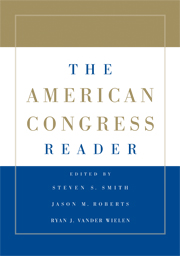Book contents
- Frontmatter
- Contents
- THE AMERICAN CONGRESS READER
- PART I THE AMERICAN CONGRESS: MODERN TRENDS
- PART II REPRESENTATION AND LAWMAKING IN CONGRESS: THE CONSTITUTIONAL AND HISTORICAL CONTEXT
- PART III CONGRESSIONAL ELECTIONS AND POLICY ALIGNMENTS
- PART IV MEMBERS, GOALS, RESOURCES, AND STRATEGIES
- PART V PARTIES AND LEADERS
- PART VI THE STANDING COMMITTEES
- PART VII THE RULES OF THE LEGISLATIVE GAME
- PART VIII THE FLOOR AND VOTING
- PART IX CONGRESS AND THE PRESIDENT
- PART X CONGRESS AND THE COURTS
- PART XI CONGRESS, LOBBYISTS, AND INTEREST GROUPS
- 36 Buying Time
- 37 “Legislative Lobbying” – Excerpt
- PART XII CONGRESS AND BUDGET POLITICS
- PART XIII FURTHER READINGS ON CONGRESSIONAL POLITICS
- References
37 - “Legislative Lobbying” – Excerpt
Published online by Cambridge University Press: 05 June 2012
- Frontmatter
- Contents
- THE AMERICAN CONGRESS READER
- PART I THE AMERICAN CONGRESS: MODERN TRENDS
- PART II REPRESENTATION AND LAWMAKING IN CONGRESS: THE CONSTITUTIONAL AND HISTORICAL CONTEXT
- PART III CONGRESSIONAL ELECTIONS AND POLICY ALIGNMENTS
- PART IV MEMBERS, GOALS, RESOURCES, AND STRATEGIES
- PART V PARTIES AND LEADERS
- PART VI THE STANDING COMMITTEES
- PART VII THE RULES OF THE LEGISLATIVE GAME
- PART VIII THE FLOOR AND VOTING
- PART IX CONGRESS AND THE PRESIDENT
- PART X CONGRESS AND THE COURTS
- PART XI CONGRESS, LOBBYISTS, AND INTEREST GROUPS
- 36 Buying Time
- 37 “Legislative Lobbying” – Excerpt
- PART XII CONGRESS AND BUDGET POLITICS
- PART XIII FURTHER READINGS ON CONGRESSIONAL POLITICS
- References
Summary
Wright offers a theoretical account of interest group influence in Congress. He contends that interest groups gain influence by offering members of Congress a valuable resource – information. Through the strategic presentation of information, interest groups have the potential to spur sympathetic members to legislative action and opponents to inaction.
Organizations attempt to influence legislative decisions through a broad range of activities. These include efforts at cultivating and maintaining good working relationships with legislators; engaging in public relations and advertising campaigns; organizing and mobilizing constituents at the grassroots; making campaign contributions; researching policy issues; gathering information about legislators' voting intentions and the legislative agenda; testifying before congressional committees; and communicating directly with legislators, their personal staff, or committee staff. All of these activities constitute what is generally referred to as lobbying. It is through these various lobbying activities that organized interests acquire and transmit information to legislators.
The argument [here] is that interest groups achieve influence in the legislative process by strategically providing information to change or reinforce legislators' beliefs about legislative outcomes, the operational effects of policies, and the electoral ramifications of their actions. The key components of this argument are developed in four sections. The first discusses the two fundamental goals of all interest groups – access and influence. A distinction is drawn between access and influence that highlights the differences between how lobbyists position themselves to present information and how they persuade legislators through the presentation of information.
- Type
- Chapter
- Information
- The American Congress Reader , pp. 414 - 426Publisher: Cambridge University PressPrint publication year: 2008

